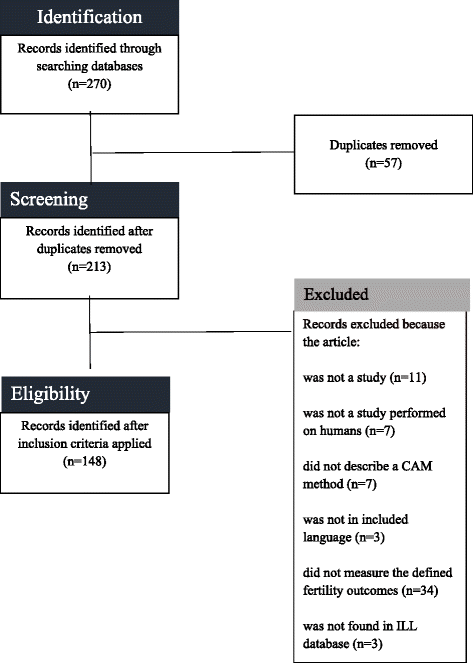Evidence for the use of complementary and alternative medicines during fertility treatment: a scoping review
- PMID: 29764413
- PMCID: PMC5952848
- DOI: 10.1186/s12906-018-2224-7
Evidence for the use of complementary and alternative medicines during fertility treatment: a scoping review
Abstract
Background: Complementary and alternative medicines (CAM) are sometimes used by individuals who desire to improve the outcomes of their fertility treatment and/or mental health during fertility treatment. However, there is little comprehensive information available that analyzes various CAM methods across treatment outcomes and includes information that is published in languages other than English.
Method: This scoping review examines the evidence for 12 different CAM methods used to improve female and male fertility outcomes as well as their association with improving mental health outcomes during fertility treatment. Using predefined key words, online medical databases were searched for articles (n = 270). After exclusion criteria were applied, 148 articles were analyzed in terms of their level of evidence and the potential for methodological and author bias.
Results: Surveying the literature on a range of techniques, this scoping review finds a lack of high quality evidence that complementary and alternative medicine (CAM) improves fertility or mental health outcomes for men or women. Acupuncture has the highest level of evidence for its use in improving male and female fertility outcomes although this evidence is inconclusive.
Conclusion: Overall, the quality of the evidence across CAM methods was poor not only because of the use of research designs that do not yield conclusive results, but also because results were contradictory. There is a need for more research using strong methods such as randomized controlled trials to determine the effectiveness of CAM in relation to fertility treatment, and to help physicians and patients make evidence-based decisions about CAM use during fertility treatment.
Keywords: Acupuncture; Complementary and alternative medicine; Infertility treatment; Mental health; Reproductive health; Scoping review.
Conflict of interest statement
Author information
Skye A. Miner is a PhD student in Sociology at McGill University. As part of the CIHR Fertility Health Lab (PI: Dr. Phyllis Zelkowitz), Skye is working on creating evidence-based content on fertility treatments for the use in a mobile health application for fertility patients. Her other research interests include understanding the ethical and social issues surrounding egg donation.
Ethics approval and consent to participate
Not applicable.
Competing interests
The authors declare that they have no competing interests.
Publisher’s Note
Springer Nature remains neutral with regard to jurisdictional claims in published maps and institutional affiliations.
References
-
- Dhillon RK, McLernon DJ, Smith PP, Fishel S, Dowell K, Deeks JJ, Bhattacharya S, Coomarasamy A. Predicting the chance of live birth for women undergoing IVF: a novel pretreatment counselling tool. Human Reproduction 2016; 31:84–92. - PubMed
-
- Aelion A, Barbieri E, Shastri S, Grill E, Chung P, Rosenwaks Z. The use of complementary medical therapies (CMT) in infertility patients. Fertil Steril. 2009;92:S33–S34. doi: 10.1016/j.fertnstert.2009.07.130. - DOI
Publication types
MeSH terms
Grants and funding
LinkOut - more resources
Full Text Sources
Other Literature Sources
Medical


